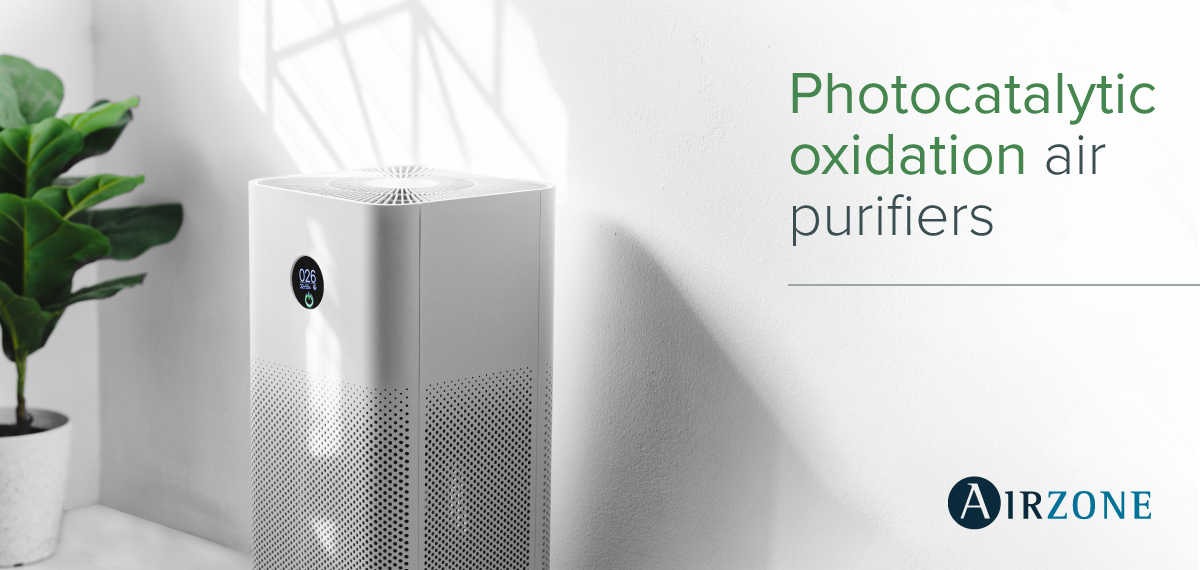


17 Jul 20

Photocatalytic Oxidation Air Purifiers
Photocatalysis has been successfully developed and used for water treatment, and since the 1990s it has been an innovative technique for treating industrial effluents in the air. This technique has been the subject of many systematic studies and laboratory research, confirming its interesting properties. Recent work carried out both outdoors and indoors has shed new light on it.
Discovered almost 50 years ago, the purifying properties of photocatalysis are used in many industrial processes. What about their efficiency regarding indoor air? Is it possible to guarantee the safety of photocatalytic systems and products in inhabited spaces?
What is the Photocatalytic Oxidation process?
The Photocatalytic Oxidation process combines UV irradiation with a substance (catalyst) titanium dioxide (TiO2) which results in a reaction that changes malignant contaminants into water, carbon dioxide and detritus. The air purification process of using photocatalytic oxidation often works by using an existing air system that pulls air through an air conditioning unit which passes through the professionally installed ultraviolet light/titanium dioxide chambers. As the malignant contaminant-filled ambient air circulates through these chambers the microbes are "attacked" by free hydroxy radicals and super-oxide ions (created by UV light and titanium dioxide) breaking their cellular structure apart and destroying both the intracellular mass and DNA/HNA chromosomes. The result is harmless water molecules, carbon dioxide and detritus.
What kind of products are available?
The photocatalytic solutions for indoor air purification are a sum of the following technologies:
- Systems that operate through ventilation (autonomous or integrated into the ventilation system).
- And photoactive interior materials.
A distinction must be made between units that are autonomous from an aeraulic point of view, i.e. equipped with their own fan, and HVAC (Heating, Ventilation and Air Conditioning) systems that are integrated into the building's air distribution network. These last systems, relatively complex, are rather intended for use in office buildings, large commercial buildings, etc.
Autonomous devices, mainly reserved for domestic use, come in the form of mobile or fixed units, such as ceiling or wall mounted units, some of which combine the functions of purification and air conditioning. They operate by recycling the air inside the room (air inducted by the unit, treated, then discharged into the room), with a number of airflow passages that is determined by the ratio between the airflow rate treated by the unit and the ventilation rate of the premises, at least 4 or 5 air changes per hour for a household depending on the nature of the pollution to be cleaned. The efficiency of the system must therefore be high for its impact on indoor air quality to be significant.
Are PCO air purifiers safe?
Most air purifiers or depolluting materials with photocatalysis use IARC8 nanoscale titanium dioxide (TiO2), classified in 2007 as a "possible human carcinogen". The possible emissions of TiO2 particles from marketed photocatalytic products and the exposure on humans remain unknown to date. Moreover, in the event of incomplete degradation of pollutants, photocatalysis can generate compounds also known as by-products that are harmful to health and the environment, such as ketones and aldehydes9. Finally, a complete degradation process can also be a source of pollutants (e.g. nitrates).
Photocatalysis applied to indoor environments is a premature technology. Predicting the behavior of purifiers through experimentation is still very difficult because of the number and variability of the parameters.
Few tests have been performed in real or controlled environments. Photocatalytic techniques, however effective they may be under certain limited laboratory conditions, have yet to be tested with respect to the operation constraints of buildings and specifics of indoor air. Currently, their effectiveness remains questionable. Some cases of deterioration in indoor air quality have even been observed because of the by-products that can have adverse health effects.
To conclude
Indoor air pollution sources must be limited and then the evacuation of pollutants through good ventilation and air circulation in buildings must be promoted.
Photocatalytic processes are far from being effective in all situations. Air purification by photocatalysis should only be considered in the framework of specific and punctual actions.
Further research must be carried out on the impacts of photocatalytic systems on the environment and health (linked to the evolution over time of semiconductors - dissemination, toxicity - and the generation of toxic by-products because of photocatalysis).
Airzone does not manufacture or distribute air purification or disinfection products. This article has been written for explanatory purposes, following the research on the five most common air disinfection technologies in the market: ozone, UVC, photocatalytic oxidation, ionization and electrostatic filtration.
Sources and links of interest:
- Observatoire de la Qualité de l’Air Intérieur. (Juin, 20212). Epuration de l’air par photocatalyse (Nº.4). https://www.oqai.fr/fr/media/brochures-et-guides/4-ateliers-bulletin-photocatalyse
- Agence de l’Environnement et de la Maîtrise de l’Énergie. (Mai, 2013). Les fiches techniques de l’ADEME - Epuration de l’air par photocatalyse. https://www.ademe.fr
- 5 Zhao et Yang. (2003) Photocatalytic oxidation for indoor air purification : a literature review
- Photocatalytic Oxidation (PCO). (n.d.). www.hamiltonthorne.com. Retrieved July 2020, from
https://www.hamiltonthorne.com/index.php/products/air-purification-systems/photocatalytic-oxidation-pco - Concordia University. (Juillet, 2015). Certain air filters using photocatalytic oxidation have dangerous by-product, study shows.
www.sciencedaily.com. https://www.sciencedaily.com/releases/2015/07/150715130835.htm